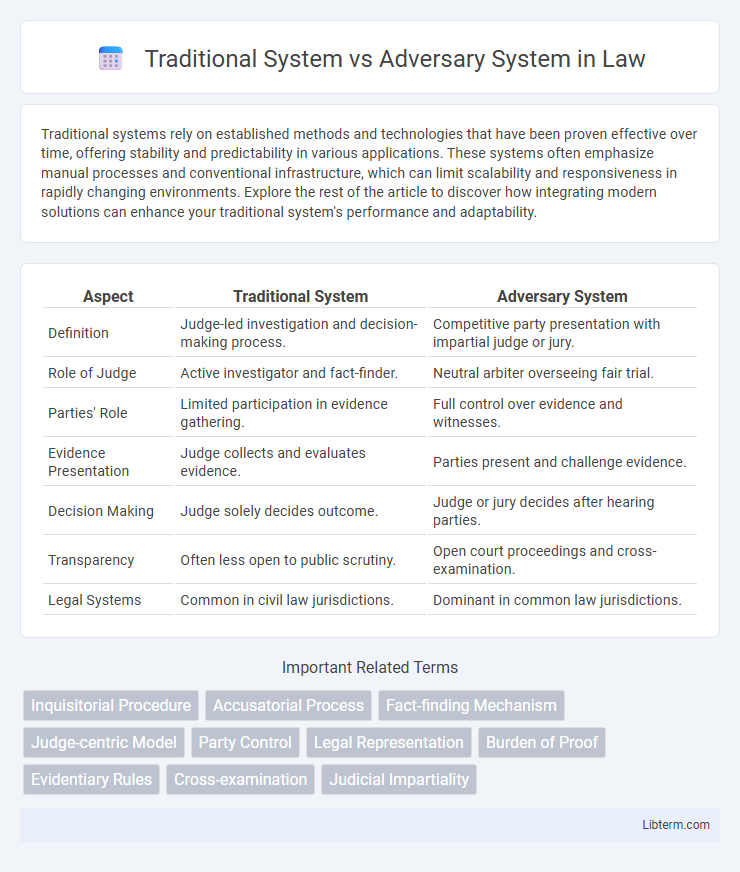Traditional systems rely on established methods and technologies that have been proven effective over time, offering stability and predictability in various applications. These systems often emphasize manual processes and conventional infrastructure, which can limit scalability and responsiveness in rapidly changing environments. Explore the rest of the article to discover how integrating modern solutions can enhance your traditional system's performance and adaptability.
Table of Comparison
| Aspect | Traditional System | Adversary System |
|---|---|---|
| Definition | Judge-led investigation and decision-making process. | Competitive party presentation with impartial judge or jury. |
| Role of Judge | Active investigator and fact-finder. | Neutral arbiter overseeing fair trial. |
| Parties' Role | Limited participation in evidence gathering. | Full control over evidence and witnesses. |
| Evidence Presentation | Judge collects and evaluates evidence. | Parties present and challenge evidence. |
| Decision Making | Judge solely decides outcome. | Judge or jury decides after hearing parties. |
| Transparency | Often less open to public scrutiny. | Open court proceedings and cross-examination. |
| Legal Systems | Common in civil law jurisdictions. | Dominant in common law jurisdictions. |
Understanding the Traditional Legal System
The traditional legal system relies on a judge-centric approach where a neutral judge evaluates evidence and arguments to determine the outcome of a case. This system emphasizes formal procedures, codified laws, and hierarchical authority, with judges playing a critical role in applying established legal principles. Understanding the traditional system involves recognizing its foundation in written statutes, judicial precedent, and an inquisitorial method that guides fact-finding and decision-making.
Overview of the Adversary Legal System
The adversary legal system is characterized by two opposing parties presenting their cases before an impartial judge or jury, with each side responsible for investigating evidence and arguing their position. This system emphasizes procedural fairness, where the truth emerges through the contest of competing arguments and cross-examinations. It is widely used in common law countries such as the United States and the United Kingdom, contrasting with the inquisitorial approach of traditional legal systems.
Historical Origins of Both Systems
The Traditional System, rooted in ancient legal customs and religious practices, evolved primarily in civil law countries emphasizing codified statutes and judicial roles as investigative authorities. The Adversary System originated in England's common law tradition during the medieval period, emphasizing a contest between opposing parties with judges acting as neutral arbitrators. Historical origins reflect diverging approaches to justice, where the Traditional System prioritizes comprehensive fact-finding by judges, while the Adversary System relies heavily on party-driven evidence presentation.
Roles of Judges and Lawyers
In the Traditional System, judges hold a central role as active investigators and decision-makers who guide the proceedings and determine the facts. Lawyers serve primarily as advisors and supporters, providing information and assisting the judge rather than actively presenting opposing cases. Conversely, the Adversary System features judges as neutral referees who ensure fair trial procedures, while lawyers take on the primary responsibility of advocating for their clients by presenting evidence and arguments to persuade the judge or jury.
Procedures for Gathering Evidence
The Traditional System relies on judges actively investigating and collecting evidence through formal inquiries, ensuring control over the evidentiary process. In contrast, the Adversary System assigns the parties the responsibility to gather and present evidence, allowing opposing sides to challenge and cross-examine witnesses. This procedural distinction impacts the transparency, efficiency, and fairness of evidence collection in judicial proceedings.
Approaches to Fairness and Justice
The Traditional System emphasizes adherence to established laws and authoritative decision-making, aiming for fairness through uniform application of rules and maintaining social order. The Adversary System prioritizes procedural fairness by allowing opposing parties to present evidence and arguments before an impartial judge or jury, ensuring justice through a competitive process. Both systems seek justice, but the Traditional System leans toward preserving community norms while the Adversary System focuses on individual rights and adversarial dispute resolution.
Strengths of the Traditional System
The Traditional System emphasizes a judge-centered approach, ensuring decisions are made by experienced legal experts who maintain strict control over proceedings and evidence. This system enhances procedural uniformity and reduces delays by following established protocols, promoting consistency in legal outcomes. Its structure supports thorough judicial oversight, which can prevent manipulation and ensure adherence to legal standards.
Advantages of the Adversary System
The adversary system promotes fairness by allowing both parties to present evidence and arguments before an impartial judge or jury, ensuring thorough examination of facts. It enhances transparency and accountability through cross-examination and the right to challenge opposing evidence, leading to more reliable verdicts. This system also upholds the presumption of innocence and protects individual rights by prioritizing the defense's role in contesting prosecution claims.
Criticisms and Challenges of Each System
The Traditional System faces criticism for its rigid procedures and limited opportunities for defense, often resulting in delayed justice and potential bias due to magistrate-controlled investigations. The Adversary System is challenged by the imbalance of legal representation, where disparities in resources can influence trial outcomes, and the reliance on oral arguments may hinder comprehensive truth-finding. Both systems confront issues of fairness and efficiency, necessitating ongoing reforms to address procedural flaws and ensure equitable access to justice.
Comparative Analysis: Which System Is More Effective?
The adversary system offers greater fairness and transparency by allowing both parties to present evidence and arguments before an impartial judge or jury, enhancing the accuracy of fact-finding compared to the traditional inquisitorial system, which relies on a judge-driven investigation. Efficiency in case resolution tends to favor the adversary system in common law countries due to its structured procedural rules, while the traditional system in civil law jurisdictions emphasizes thoroughness over speed, potentially leading to longer trial durations. Empirical studies suggest that the adversary system fosters stronger adversarial debate and legal advocacy, but the traditional system's centralized control can reduce bias and prevent procedural abuses, affecting overall effectiveness based on jurisdictional context and legal culture.
Traditional System Infographic

 libterm.com
libterm.com